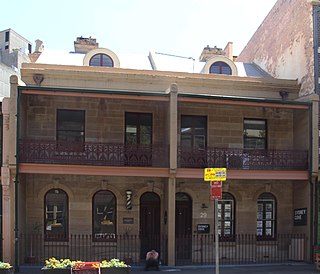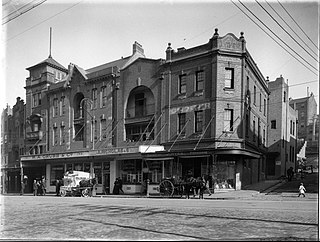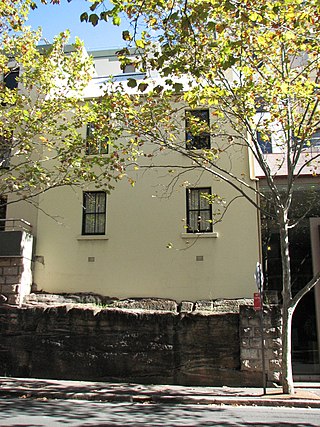
Grosvenor Street is a street in the central business district of Sydney in New South Wales, Australia. Grosvenor Street runs 350 metres (1,150 ft) in an east to west direction, with traffic flowing in both directions. The eastern terminus is at George Street and the western terminus is at the junction of York Street with the Bradfield Highway. There are no major cross streets.

The Australian Hotel is a heritage-listed hotel at 100–104 Cumberland Street, The Rocks, City of Sydney, New South Wales, Australia. The current structure was constructed from 1914 to 1915, and Property NSW owns the property, being added to the New South Wales State Heritage Register on 10 May 2002.

The New York Hotel is a heritage-listed former hotel located at 153–155 George Street in the inner city Sydney suburb of The Rocks in the City of Sydney local government area of New South Wales, Australia. It was built during 1908. It is now part of the modern Duty Free Store complex. The property is owned by Property NSW. It was added to the New South Wales State Heritage Register on 10 May 2002.

The Brooklyn Hotel is a heritage-listed bar, restaurant and former hotel located at 229 George Street, in the suburb of The Rocks, in the city of Sydney, New South Wales, Australia. It was designed by Walter Liberty Vernon and built in 1912. The property is owned by Property NSW, an agency of the Government of New South Wales. It was added to the New South Wales State Heritage Register on 10 May 2002.

Playfair's Terrace are heritage-listed terrace houses located at 1–7 Atherden Street in the inner-city Sydney suburb of The Rocks in the City of Sydney local government area of New South Wales, Australia. It was built in 1880. It is also known as Playfairs. The property is owned by Property NSW, an agency of the Government of New South Wales. It was added to the New South Wales State Heritage Register on 10 May 2002.

The Old Ambulance Station, The Rocks is a heritage-listed former ambulance station and public house and now the head quarters of The Argyle Network, a technology recruitment business located at 73 George Street in the inner city Sydney suburb of The Rocks in the City of Sydney local government area of New South Wales, Australia. It was built from 1842 to 1843 and the front facade was designed in 1927-8 by Howie Moffot & Co. It is also known as the Former Central District Ambulance Station and Ken Duncan Gallery. The property is owned by Property NSW, an agency of the Government of New South Wales. It was added to the New South Wales State Heritage Register on 10 May 2002.

Johnson's Building is a heritage-listed former retail stores and now stock exchange offices, bar and restaurant located at 233–235 George Street in the inner city Sydney suburb of The Rocks in the City of Sydney local government area of New South Wales, Australia. It was designed by Walter Liberty Vernon and built in 1912. It is also known as Chamber of Commerce Building and Johnson's Overalls Building (Johnsons). The property is owned by Property NSW, an agency of the Government of New South Wales. It was added to the New South Wales State Heritage Register on 10 May 2002.

The Royal Naval House is a heritage-listed former Royal Australian Navy amenities and accommodation building and now commercial building located at 32–34 Grosvenor Street in the inner city Sydney suburb of The Rocks in the City of Sydney local government area of New South Wales, Australia. It was designed by Varney Parkes and G. W. Landers and built from 1890 to 1907. It is currently known as the Sydney Futures Exchange. The property is owned by Property NSW, an agency of the Government of New South Wales. It was added to the New South Wales State Heritage Register on 10 May 2002.

Federation Hall is a heritage-listed former meeting hall and theatre and now commercial building that houses the Sydney Futures Exchange located at 24–30 Grosvenor Street in the inner city Sydney suburb of The Rocks in the City of Sydney local government area of New South Wales, Australia. It was built from 1889 to 1891, with alterations designed by Scott and Green. It is also known as Exchange Courtyard and Meat Board Building. The property is owned by Property NSW, an agency of the Government of New South Wales. It was added to the New South Wales State Heritage Register on 10 May 2002.

The Old Bushells Factory is a heritage-listed former Bushells Tea factory and warehouse, now used as shops, offices and an art gallery, located at 86–88 George Street in the inner city Sydney suburb of The Rocks in the City of Sydney local government area of New South Wales, Australia. No. 86 was designed by Walter Liberty Vernon; and both buildings were built from 1886 to 1912. It is also known as the Old Bushells Factory and Warehouse; Bushells Place; Bushells Warehouse and Bushells Offices; and Health Commission Building (Bushell's). The property is owned by Property NSW, an agency of the Government of New South Wales. It was added to the New South Wales State Heritage Register on 10 May 2002.

The Metcalfe Bond Stores is a heritage-listed former bond store and warehouse and now shops and offices located at 68–84 George Street in the inner city Sydney suburb of The Rocks in the City of Sydney local government area of New South Wales, Australia. It was built from 1912 to 1916. It is also known as New Metcalfe Bond Stores. The property is owned by Property NSW, an agency of the Government of New South Wales. It was added to the New South Wales State Heritage Register on 10 May 2002.

Harrington's Buildings is a heritage-listed hotel and former offices and store located at 53–65 George Street in the inner city Sydney suburb of The Rocks in the City of Sydney local government area of New South Wales, Australia. It was built from 1924 to 1925 by Concrete Constructions Limited. It is also known as Old Sydney Holiday Inn and Old Sydney Park Royal Hotel. The property is owned by Property NSW, an agency of the Government of New South Wales. It was added to the New South Wales State Heritage Register on 10 May 2002.

29–31 George Street are two heritage-listed former terrace houses and now offices located at 29–31 George Street in the inner city Sydney suburb of The Rocks in the City of Sydney local government area of New South Wales, Australia. It was built in 1866. The property is owned by Property NSW, an agency of the Government of New South Wales. It was added to the New South Wales State Heritage Register on 10 May 2002.

The NSW Housing Board Building is a heritage-listed former police station and government building and now commercial offices located at 16–18 Grosvenor Street in the inner city Sydney suburb of The Rocks in the City of Sydney local government area of New South Wales, Australia. It was designed by William Henry Foggitt and built in 1921 by J. McCarthy. It is also known as NSW Housing Board Building (former) and Charlotte House. The property is owned by Property NSW, an agency of the Government of New South Wales. It was added to the New South Wales State Heritage Register on 10 May 2002.

182 Cumberland Street, The Rocks is a heritage-listed retail building and residence located at 182 Cumberland Street, in the inner city Sydney suburb of The Rocks in the City of Sydney local government area of New South Wales, Australia. It was designed by Walter Liberty Vernon with the assistance of E. L. Drew and built from 1911 to 1912. The property is owned by Property NSW, an agency of the Government of New South Wales. It was added to the New South Wales State Heritage Register on 10 May 2002.

107–109 George Street, The Rocks is a heritage-listed restaurant and former retail building, residence and bakery located at 107–109 George Street, in the inner city suburb of The Rocks in the City of Sydney local government area of New South Wales, Australia. It was built during 1860. It is also known as Rockpool Restaurant (former); and William Blue Dining. The property is owned by Property NSW, an agency of the Government of New South Wales. It was added to the New South Wales State Heritage Register on 10 May 2002.

149–151 George Street, The Rocks is a heritage-listed duty-free store complex and former retail building and residence located at 149–151 George Street, in the inner city Sydney suburb of The Rocks in the City of Sydney local government area of New South Wales, Australia. It was built from 1913 to 1913. It is also known as part of the Duty Free Store complex. The property is owned by Property NSW, an agency of the Government of New South Wales. It was added to the New South Wales State Heritage Register on 10 May 2002.

145 George Street, The Rocks is a heritage-listed duty-free store complex and former retail building and residence located at 145 George Street, in the inner city Sydney suburb of The Rocks in the City of Sydney local government area of New South Wales, Australia. It was built in 1892. It is also known as Currently part of Duty Free Store complex. The property is owned by Property NSW, an agency of the Government of New South Wales. It was added to the New South Wales State Heritage Register on 10 May 2002.

71 Harrington Street, The Rocks are heritage-listed serviced apartments and former terrace houses and shops located at 71 Harrington Street, in the inner city Sydney suburb of The Rocks in the City of Sydney local government area of New South Wales, Australia. It was built from 1860. It is also known as Sailors Return Hotel; Stafford Apts. and 75 Harrington Street; Clocktower Development. The property is owned by Property NSW, an agency of the Government of New South Wales. It was added to the New South Wales State Heritage Register on 10 May 2002.

105 George Street, The Rocks is a heritage-listed shop and former residence located at 105 George Street, in the inner city Sydney suburb of The Rocks in the City of Sydney local government area of New South Wales, Australia. It was built during 1851 by persons unknown and redeveloped in 1985 by the Sydney Cove Redevelopment Authority with Co-Wyn Construction. It is also known as Kathmandu (current) and Beach Culture and Dorian Scott (former). Property NSW, an agency of the Government of New South Wales. It was added to the New South Wales State Heritage Register on 10 May 2002.





















